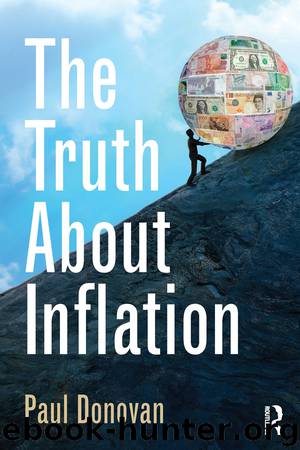The Truth About Inflation by Paul Donovan

Author:Paul Donovan
Language: eng
Format: epub
ISBN: 9781317690030
Publisher: Routledge
Printing money and investing
Printing money does not create inflation – if nothing else that is the one message investors should take from this chapter. Roosevelt’s printing of money in 1933 did not create inflation, because it was absorbed by a demand for narrow money on the part of the American public of the day. Japan’s prolific production of cash over the past quarter century has not created any meaningful inflation, as much of the cash that has been printed has been tucked away under the metaphorical futon. Similarly, six years after central banks embarked on a significant increase in narrow money supply across the industrialised world, an increase in money that aimed to avoid repeating the depression-inducing errors of the 1930s, inflation has yet to appear because that liquidity has been absorbed by demand. As long as the increased money supply is gathering dust under the mattress, or sitting idle on corporate balance sheets, the increase in money supply presents no significant inflation threat.
Investors need to have two concerns when it comes to money printing. The first is largely unconnected to inflation, and it is that the action of printing money will generally create some distortion in financial markets as the central bank purchases assets in a liquefaction process. This will generally mean that more risk has to be taken by investors if they wish to achieve a specific rate of return.
The second concern is inflation related. Investors need not worry about the inflationary consequences of printing narrow money, but they do need to be aware of the inflationary consequences of printing narrow money relative to the fluctuating levels of narrow money demand. Money demand is not simply identified, and the difficulty of pinpointing the level of money demand is one reason why central banks may periodically make mistakes and allow inflation or deflation episodes to arise.
The final point to make when considering money printing and inflation is around the independence of central banks. Political interference in the conduct of central banks is almost a necessary requirement for too much money to be printed. From medieval China via Weimar Germany to Zimbabwe, political addiction to the ease of printing money means that political interference all too often equates to too much money being printed. An independent central bank can make mistakes in its estimation of the levels of narrow money demand, and that may cause a temporary inflation surprise, but an independent central bank has measures it can take to reverse the excess money problem (either by reducing narrow money supply or artificially increasing narrow money demand).
Perhaps the best rule of thumb for investors is that printing money with a politically compromised central bank is likely to lead to inflation. If the central bank is politically independent, run by economists, then investors can afford to relax a little about the inflation consequences of any money printing that is undertaken.
Download
This site does not store any files on its server. We only index and link to content provided by other sites. Please contact the content providers to delete copyright contents if any and email us, we'll remove relevant links or contents immediately.
International Integration of the Brazilian Economy by Elias C. Grivoyannis(57351)
The Radium Girls by Kate Moore(10914)
Turbulence by E. J. Noyes(7048)
Nudge - Improving Decisions about Health, Wealth, and Happiness by Thaler Sunstein(6637)
The Black Swan by Nassim Nicholas Taleb(6199)
Pioneering Portfolio Management by David F. Swensen(5610)
Rich Dad Poor Dad by Robert T. Kiyosaki(5155)
Zero to One by Peter Thiel(4831)
Man-made Catastrophes and Risk Information Concealment by Dmitry Chernov & Didier Sornette(4744)
Secrecy World by Jake Bernstein(3787)
Millionaire: The Philanderer, Gambler, and Duelist Who Invented Modern Finance by Janet Gleeson(3573)
Skin in the Game by Nassim Nicholas Taleb(3473)
The Age of Surveillance Capitalism by Shoshana Zuboff(3428)
The Money Culture by Michael Lewis(3290)
Skin in the Game: Hidden Asymmetries in Daily Life by Nassim Nicholas Taleb(3270)
Bullshit Jobs by David Graeber(3182)
The Dhandho Investor by Mohnish Pabrai(3171)
The Wisdom of Finance by Mihir Desai(3083)
Blockchain Basics by Daniel Drescher(2894)
